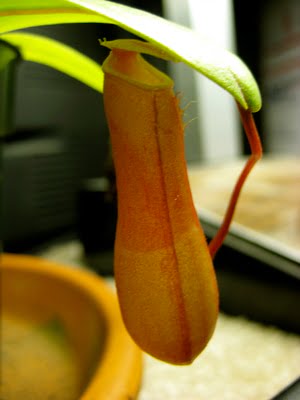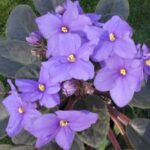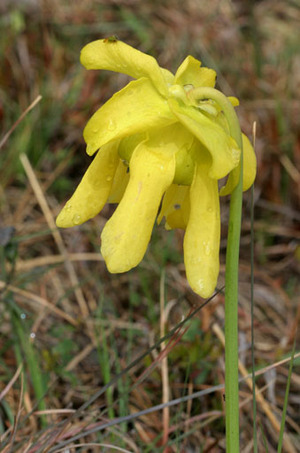Carnivorous plants are often regarded as exotic and difficult to grow. This part of the allure of carnivorous plants as well as their unusual anatomy and nutritional habits. Not all carnivorous plants are hard to take care of. While they do require more diligent care then most houseplants, the following carnivorous plants can be grown on most sunny windowsill or patio. All carnivorous plants need very pure water. Distilled water should be used unless there is exceptional clean and clear tap water.
Sundews – The genus of plants named Drosera, are more commonly known as the Sundews and are some of the easiest and most intriguing. Every leaf of the Sundew is covered in tiny hairs, which each secretes a single small drop of sticky dew. Insects that land on the plant will quickly get stuck. In many species of Sundew, as the insect struggles to get free its thrashing will cause the leaf to roll up around it. In other species, nearby leaves will move toward the prey, maximizing contact with digestive enzymes secreted from the leaves. While not as dramatic as a Venus flytrap, these movements are very fast for a plant, happening in minutes.
I recommend Drosera capensis, the Cape Sundew for beginners. It can easily be grown in a sunny windowsill, is a very vigorous and attractive grower and will even produce many small flowers.
Soil – Sundews like a soil mix that is low in nutrients, mildly acidic and can hold water. A mix of one part peat moss to one part perlite or sand is good.
Light – Sundews prefer full sun. A south or west-facing window is ideal. The more sun your plant gets the more dew it will produce. More sun may also cause the leaves of some Sundews to turn slightly red.
Water – Always water your Sundew and all carnivorous plants for that matter, with water that is low in dissolved minerals. If you live in a hard water area used distilled water. Sundews must remain moist at all times. I find it easiest to use the tray method for watering, placing the plant in a very large tray of water and refilling it every few days.
Winter Care – Some Sundews native to temperate regions require a dormant period in winter. The Cape Sundews are native to Africa and require no dormancy. During winter, you may notice that your Sundew will grow more slowly and produce less dew. This is normal, when the days start to get longer in spring, your Sundew’s growth will pick up, and it may even produce flowers. The flowers bloom from a tall stalk sent up from the plant. Each stalk produces around a dozen small, exquisite purple flowers.
Sarracenia – Sarracenia, also known as the trumpet pitchers are carnivorous plants native to North America, specifically the South-eastern United States, extending all the way up the east coast and to parts of Canada. The leaves of Sarracenia are rolled into a long tube with an open top and a hood. The size, shape and color of the pitchers are different for each species with many hybrid forms. All the most commonly found Sarracenia species found in nurseries have similar care requirements and Sarracenia in general are very hardy and perfect for beginners.
Soil – Sarracenia live in soil that is constantly moist and somewhat acidic. Generally, a soil mix similar to that of Sundews is good.
Light – North American pitcher plants prefer full sun, with little or no shade. Direct sun will increase the color of the pitchers.
Water – Treat like a Sundew, the tray method is simplest. During winter dormancy your Sarracenia will require less water, but you should never let it dry out.
Winter Care – Sarracenia require a dormant period during winter triggered by a fall in temperature and day length. Because of this, it is best to grow Sarracenia outside if you live in USDA Zone 8 or higher. Sarracenia are one of the hardiest carnivorous plants and can tolerate mild frosts. They are, however, susceptible to freezes. If you believe there will be a deep freeze, you should cover your plants with plastic or move them to a cool interior location. During the winter, many of the pitchers will die off and the remaining ones will turn brown. This is normal, and new growth will appear when temperatures begin to warm. In spring, if your plant is mature, it may produce, pinwheel shaped flowers. Towards the end of the growing season, some Sarracenia species will produce more non-carnivorous leaves, called phyllodia.
Nepenthes – Nepenthes are the orchids of carnivorous plants. Some are relatively simple to grow while others are very difficult. They have been bred many times, creating complex hybrids in a huge variety of shapes and sizes. Nepenthes, however, aren’t admired for their flowers but for their pitcher shaped traps. The showy traps grow from the tips of each leaf. In botanical terms, the traps are the leaves, rolled up into a pitcher shape and the flat part is actually a modified leaf base.
Nepenthes are separated into two main categories depending on the elevation at which they live in the wild and the corresponding climate. Lowland Nepenthes grow mainly in tropical jungles where humidity is high, temperatures are always hot and there is hardly any fluctuation in temperatures. Highland Nepenthes grow in the cooler jungles in mountains at higher elevations. They experience cooler average daytime temperatures and a temperature drop of up to 10˚F at night.
Soil – Unlike some carnivorous plants, Nepenthes must have a soil mix that drains quickly because Nepenthes hate to sit in water. Pure long fibered sphagnum moss will work as well as a mix of one part peat and 2 parts perlite.
Light – Most Nepenthes like bright, indirect light. In more direct sun some Nepenthes will take on a brown or olive tint to the leaves. A south-facing window is best and an east-facing window with direct morning sun will also do. A west window could work but the hot afternoon sun might be too intense.
Water – Nepenthes like their soil to be constantly moist, but never stand in water. Never use the tray method with nepenthes because their roots can easily rot. During the winter months your nepenthes will slow down its growth and will require slightly less water.
I recommend Nepenthes ventricosa for beginners. N. ventricosa is a highland plant native to the Philippines meaning it appreciates a drop in temperature at night. You’re your nepenthes is in a windowsill, it will probably experience an adequate fluctuation in temperature. N. ventricosa has tubby, pot shaped pitchers that are red.





